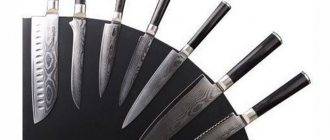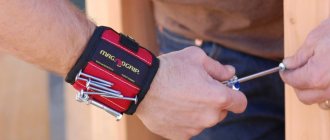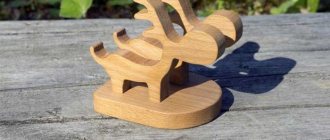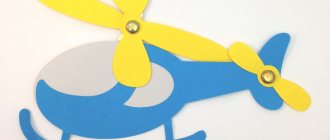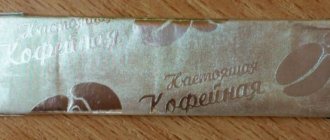Making an organizer (holder) for a socket wrench and its sockets
Once I bought a wrench in this format:
Socket heads for unscrewing/tightening nuts and a T-shaped wrench for them. 1/4″ mount (this is 6.35 mm - the size of the side of the square mount). Heads of different sizes are sold separately, strung on plastic ears... but how to store it all? To make it convenient to use.
But finding and removing the necessary heads (and even picking up the knob) is very inconvenient. Therefore, we quickly come up with, develop and manufacture a holder (stand, organizer, box) of the following final form:
I didn’t start filming a “shocking video” here about how to cut out figures from plywood with a jigsaw, drill and glue them... because all this is too primitive, no technological tricks. The main thing here is the design idea. And she is like this:
- In a strip of plywood 15 x 2 cm we drill 10 holes for 6 mm furniture dowels.
- We cut the first 6 dowels (for small heads) so that 10 mm sticks out from the top, otherwise the heads will dangle on them. We glue the dowels.
- Using a jigsaw, we cut out 4 figures of the stand for the collar and glue them to the strip with dowels.
Read more. The distance between the dowels is determined as the sum of the diameters of two adjacent heads, divided in half, plus 1.2 mm. The result is this:
For the collar, we make a stand next to it, as for a Japanese sword:
At the extreme stops, you need to grind the top down to a slope to make it easier to install the knob. The middle supports are glued at such a distance from each other and from the edges that the head of the crank can be located in the center or closer to either end. The depth of the grooves in the supports (and these grooves also widen upward for ease of throwing and installing the wrench) is such that the overhanging head of the wrench does not reach the floor (it turns out 12 mm from the floor to the handle of the wrench).
You can also make signatures on the plywood of the dimensions of the heads so that they can be seen from above:
Photo 6. Relationship between dimensions in mm and metric standards such as M2, M3, M4, M5, M6, M8
On the heads there are inscriptions of their sizes in mm - this is the distance between two opposite flat edges of the nut (see photo on the left). This is bad. Nuts, screws, and bolts are sold by the name of their metric thread, and they are also convenient to store. Although the external dimensions of the nut can be different for the same thread, there is still a basic, most common correspondence:
| M2 | M3 | M4 | M5 | M6 | M8 |
| 5 mm | 5.5 mm | 7 mm | 8 mm | 10 mm | 13 mm |
Therefore, these inscriptions M8, etc. on the resulting organizer-holder are very important: having grabbed a nut from a cell or box with the inscription M8, now we quickly grab the same socket head of the wrench, and do not strain our brains, remembering the correspondence.
PS There are two errors in Photo 6: M8 should be written at the last head, on which 13 mm is written, M3 is the second from the far end of the bit, with 5.5 mm written on it. The table above is correct.
Update 04/19/2021
A table of correspondence between nut threads (or bolt heads) and key sizes (or socket heads) in the form of one picture, which is convenient to store and view on a smartphone:
What is a wrench?
To cope with various fasteners, you need to have special tools in your arsenal. One of the most popular is the impact wrench. Its main task is interaction with threaded connections. The device belongs to the universal category. Often used by auto mechanics and craftsmen of various profiles. You can see it on construction sites and in everyday life - wherever there is a need to tighten nuts and bolts.
The functionality is superior to a wrench. Helps to quickly finish the job, making it much easier. It looks similar to a drill or screwdriver, but there are a number of design differences. In the manufacture of products, materials that are resistant to significant loads are used. Most popular models have a metal case, although there are budget options made of impact-resistant plastic. Which one is better to buy depends on the personal preferences of the master and the scope of use of the device.
The handle is rubberized. Able to provide a reliable and comfortable grip. The case may have rubberized inserts to minimize the possibility of slipping out of your hands. The best devices are those with heat-resistant linings in the body area. They help avoid burning your palms when exposed to high heat. Steel or brass is used in the production of the working mechanism.
Types of impact wrenches
Modern instruments are divided into:
- Drums. Suitable for commercial use. Rotational movements are converted into rotational jerks due to the presence of an impact mechanism. The second name is an impact wrench.
- Unstressed. Inexpensive rotational type devices. Designed for home use.
Devices are distinguished by the method of movement, and therefore they are divided into the following groups:
- self-propelled;
- portable;
- transported;
- stationary.
Products and drive types vary. The classification is as follows:
- Manual or “meat grinder”. Belongs to the mechanical type. The operator must exert effort when working with it. Often found at service stations. The main task is to remove the nuts on the wheels of the car.
- Rechargeable. Manufacturers equip products with removable batteries. The main advantage is autonomy and practicality. Will handle rusty nuts and bolts. The rotating torque can be adjusted at your discretion. You can also change the direction of rotation. Equipped with a brushless motor. They are durable.
- Network. The design includes an electric drive. To operate, you must have a single-phase AC power supply in the immediate vicinity. Compact, reliable, a little noisy. They have high efficiency.
- Pneumatic. An integral attribute in a car repair shop of any level. Equipped with a metal housing to which the compressor can be connected via a hose. The air supply is adjusted with a screw. Light weight. Available in impact and non-impact types.
- Petrol. The name indicates that the tool is equipped with a gasoline engine. A distinctive feature is high power and autonomy. It can often be found in the hands of railway layers and repairers.
- Hydraulic. It is very popular due to the ability to control torque. The engine is replaced by a hydraulic pump with a distributor. The maximum permissible torque is 10,000 Nm. It will become an indispensable assistant where you need to put a lot of effort into unscrewing the nuts. There are end and cassette types. The latter, in turn, are divided into detachable and solid.
Based on the position of the chuck relative to the body, impact wrenches are produced:
- End ones. Classic device. According to buyers, it is the most convenient to use. The rod is removed from the body through the end.
- Lateral (corner). The angle of the rod under the head is 90 degrees.
Homemade magnetic key holder
Greetings to all DIYers, in this article I will tell you how the author made a useful device in the form of a holder for key heads. Since storing tools, namely small parts, for example, heads for keys or bolts, can be difficult, so this idea was implemented. Professionals purchase tools separately and store them in a special case, but this is an extra expense. So, why not make a homemade magnetic key holder, which can be a good replacement for the most inexpensive storage option. Another plus is that each individual head will be kept in its rightful place and you won’t be afraid of losing them during transportation.
To make this useful homemade product, you need the following materials:
*Program for designing a vector image (Corel Draw). *Laser cutter. *Board thickness 130 mm, 5 x 20 cm (poplar). *Board thickness 64 mm, 5 x 40 cm (walnut). *Magnetic strip 40 cm long. *Epoxy resin. *Sandpaper. *Acrylic lacquer.
Step one. Creating a project in Corel Draw
First, you need to create a sample from which this holder blank will be laser cut. To do this, you need to have at least some basic skills in constructing vector images.
First, do the required number of circles. In the process, they will become holes into which the heads for the keys will be inserted. Make the circles with a free play allowance of + 0.05 cm so that during use you can easily insert your heads into the finished cells.
Place the circles evenly, keeping a gap of a few millimeters between them. When all the circles are ready, mark the outline of a rectangle around them, which will be the basis. The angles can be different, both regular and curly, as in our project.
Source
Adapters, adapters and their characteristics
Specially produced for this purpose attachments, adapters, and other additional devices help improve the functionality of any tool. They help speed up work and make it less labor-intensive. Thus, adapters, also known as “holders,” are able to limit the depth of insertion of the self-tapping screw into the base.
The structural elements of the adapters are:
- Landing base. It fits into the tool chuck and is firmly fixed in it.
- Magnetic element. Designed to hold magnetic bits. Replacing one bit with another is done in a matter of seconds.
DIY magnetic key holder for bookmarks 9
Storing tools, especially small parts like wrench sockets, bolts, etc., can sometimes be difficult. Non-professionals often purchase tools separately and storing them in a special case or box is an extra expense. However, a convenient homemade magnetic key holder can be an excellent alternative to a more expensive storage option. In addition, each head will be securely fixed in its own cell, and the entire box can be transported without fear of losing them.
- Vector image creation program (Corel Draw);
- laser cutter;
- board 130 mm thick, 5 x 20 cm (poplar);
- board 64 mm thick, 5 x 40 cm (walnut);
- magnetic strip 40 cm long;
- epoxy resin;
- sandpaper;
- acrylic lacquer.
Step 1: Create a project in Corel Draw
First of all, it is necessary to create a layout, according to which the exact blank of the holder will be cut out with a laser. To create a layout, you must have skills in constructing vector images.
First, create the number of circles you need. These will become the holes into which you will insert the sockets for the keys. Make circles the size of the diameter of the heads themselves + 0.05 cm. This is necessary so that during operation you can freely insert your heads into the prepared cells.
Distribute the circles evenly, leaving a gap of a few millimeters between them. Once you have placed all the circles, draw a rectangle around them. You can leave the corners as usual or design them figuratively, as in this project.
Additional devices for main equipment
Any tool will bring more benefits to its owner if it is equipped with additional devices:
- Adapter for bits. An integral attribute for screwdrivers and impact wrenches. Helps to hold equipment of different parameters and with different configurations of the working part.
- Adapter for socket heads. Often purchased for working with impact wrenches. The main purpose is to hold end attachments of various diameters.
- Cardan. It is needed when it is necessary to cope with fasteners located in hard-to-reach places or at an angle. It consists of two structural elements connected to each other by a hinge. The first part is mounted to the tool, the second is designed to accommodate the socket head.
- Extension cord. Allows you to unscrew or tighten fasteners located in hard-to-reach areas where it is almost impossible to reach with a tool. The length can be up to 30 cm. Often used for heads and bits.
- Universal holder. Often purchased by users of impact wrenches and screwdrivers. Designed for mounting a variety of attachments.
Socket socket holder
Authorization on the site
Hello to all DIY lovers!
In one of my previous works, I described the manufacture of a holder for open-end wrenches, see my article: “Holder for open-end wrenches.”
However, in addition to open-end wrenches, to work with threaded fasteners, it is often necessary to use socket heads. So I decided to make a wall holder for them too.
I must say that I have this set of socket heads with a key and a plastic holder.
However, the problem is that while some heads are quite difficult to remove from the holes in this holder, others, on the contrary, barely hold on and sometimes fall out, since the holes for them are already loose. And the dimensions indicated on the sides of the heads are not at all visible due to the high walls of the holder. Practice has shown that this holder is convenient to take with you if necessary, but it is not very convenient for working in the workshop.
Thinking about various options for a homemade wall holder, I first decided to settle on the most seemingly optimal option, in which the socket heads are simply inserted into holes drilled in the board.
However, since the diameters of adjacent heads do not differ very much (literally by 0.5-2 mm), it is very difficult to select drills or crowns for wood to drill holes for them.
Of course, it was possible to bore some of the holes using a round wood file, but then I came up with a better idea.
I decided to make a holder where the sockets would simply slide onto the vertical pins. Moreover, as such pins, you can use screws with plastic tubes put on them. Naturally, making such a holder is also much simpler than a holder with holes.
Manufacturing process
To begin with, we use a plane to chamfer the front edges of the blank board, or better yet, even round them a little.
Then we mark the board that will serve as a holder, and drill holes with a diameter of 4 mm at its ends for the screws with which we will attach the holder to the wall.
We countersink these holes for the screw heads using a spherical wood cutter.
Now we saw off the ends of the holding board with a jigsaw.
Then we carry out the processing with sandpaper and screw the magnetic knife holder to the left side of the holder board.
For this purpose, I took an old short knife holder that was hanging in our kitchen. But now a new holder has been hung in the kitchen, and this one is just right for hanging the four smallest keys.
Immediately behind the magnetic holder, we prick with an awl and drill two blind holes using a drill with a diameter of 2.5 mm.
We drill these holes to a depth of approximately 10 mm.
The distance between these holes should be equal to the width of the handle of the key that we will hang in this place, plus approximately 10-14 mm, for large keys (from 20 mm or more), or 7-10 mm, for small ones (less than 20 mm.).
Then we cut off two identical pieces of cambric or plastic tube, approximately 6-10 mm long, again the length of these pieces depends on the size, and, in particular, on the thickness of the particular key.
By the way, if you don’t have a suitable cambric at hand, or it’s just a pity to use it for such purposes, then you can simply use these plastic tubes from bottles of liquid soap.
I just used them. These tubes fit well in diameter to screws with a press washer.
What types of adapters are there?
A distinctive feature of the devices is their shape.
| Varieties | Description |
| Under the head | On one side there is a hexagonal nozzle for a cartridge, on the other there is a connecting square for a certain type of head: 3/8, ¼ or ½ inch. |
| Corner type | The name speaks for itself. The self-tapping screw is located at an angle to the surface and the screwdriver will not fit there. It’s impossible to do the job without an adapter. |
| Flexible type | A distinctive design feature is the presence of a long flexible rod that is able to reliably hold its shape. |
| Direct | Classic devices. Ideal for screwing fasteners into the wall. They work where there are no obstacles for fixing screws. |
Experts advise that in order to avoid mistakes when choosing, you need to understand the classification. The presence of adapters for bits and adapters for impact wrenches will help give the tool versatility and make it possible to manipulate equipment of any size and type. If you securely fasten the intermediate element, you can increase the transmission of torque from the spindle to the nozzle. Installation is simple and quick: just clamp the shank in the mounting hole of the equipment, and install the equipment into the free end. Moreover, it must be selected so that it matches the type of shank.
Experts recommend choosing models of nozzles with magnetic tips. They promote better retention.
Rating of high-quality flexible adapters and adapters
FORCE 8044225F 1/2″, 225 mm
This popular model is made from chrome vanadium steel. The stated fit square is ½ inch. The length of the product is 22.5 cm. A flexible adapter is responsible for increased ease of use. Produced by a time-tested Taiwanese brand. Assembly is carried out in the same country. Supplied in original packaging. The weight of the set is 0.64 kg.
Average price – 2202 rubles.
FORCE 8044225F 1/2″, 225 mm
Advantages:
- time-tested manufacturer;
- comfortable fit;
- practicality;
- build quality;
- flexible extension.
Flaws:
- not identified.
AIST 43508F 00-00003250 200 mm, 1/2″
For the manufacture of this practical device, chrome vanadium steel is used, which is characterized by increased strength and resistance to mechanical damage. Length – 20 cm. Landing square – ½ inch. For increased ease of use, there is a flexible adapter that allows you to work in confined spaces. Set weight – 0.24 kg. Product from a time-tested domestic manufacturer. Please note that assembly is carried out in Russia.
You can purchase the set for RUB 1,266.
AIST 43508F 00-00003250 200 mm, 1/2″
Advantages:
- quality product from a Russian manufacturer;
- Excellent value for money and quality;
- the ability to order online through the company’s online store;
- universal landing square;
- practicality.
Flaws:
- not identified.
JTC-7817 (1/2″; 200 mm)
This practical design features a flexible element that allows you to work in confined spaces. Set weight – 0.21 kg. The length of the product is 20 cm. The diameter of the landing square is ½ inch. Made from chrome vanadium steel alloy. It is based on a flexible element that allows manipulation in hard-to-reach areas. Produced by a famous Taiwanese company.
Average price – 940 rubles.
JTC-7817 (1/2″; 200 mm)
Advantages:
- build quality;
- flexible element;
- long service life;
- practicality;
- compactness.
Flaws:
- not identified.
AvtoDelo 39776 15170 (250 mm; 1/2DR)
Compact and practical solution with a ½ inch mounting square. It is based on the use of a flexible element that will allow the user to get into hard-to-reach areas. Length – 25 cm. The instrument is made of chrome vanadium steel alloy. The component manufacturing company is Russian. Assembly is carried out on the territory of the Middle Kingdom. The weight of the set is 0.35 kg.
Cost – 429 rubles.
AvtoDelo 39776 15170 (250 mm; 1/2DR)
Advantages:
- practicality;
- flexible element;
- time-tested manufacturer;
- compactness;
- build quality.
Flaws:
- not identified.
How to choose a product
Experts recommend paying attention to the following nuances when choosing products:
- Material of manufacture. The most inexpensive option is a tool-type steel product. If you have to work with a wrench, it is recommended to give preference to a more practical and wear-resistant material, such as chrome vanadium or chrome molybdenum alloy.
- The diameter of the mounting hole and the type of fastening used. A suitable adapter must match the mounting hole of the equipment being used.
- The number of auxiliary elements in the set. Adapters can be purchased individually or as a set (from 3 to 5 pieces).
There are two options where to buy the required product. It is advisable to visit a specialized retail outlet and familiarize yourself with the assortment presented. A professional seller will tell you how to make the right choice. You can order products online in the online store. It is advisable to first check the supplier for integrity. Otherwise, you may end up with the wrong equipment.

